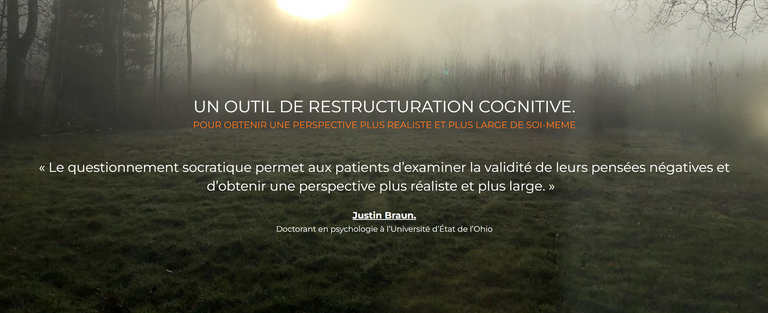
Mr Alain Sadzawka,
practitioner in conversational therapy.
I propose a Socratic therapy based on questioning and inner dialogue.
Mr Alain Sadzawka,
praticien en thérapie conversationnelle.
je propose une thérapie socratique basée sur le questionnement et le dialogue intérieur.
The Socratic dialogue is a free verbal exchange between the patient and the therapist whose goal is deepening, discovery and elucidation.
Le dialogue socratique est un échange verbal libre entre le patient et le thérapeute dont le but est l'approfondissement, la découverte et l'élucidation.
What does "normal" mean? My mother is normal, my brother is normal. I don't want to be like them!
- Benoît Peeters and François Schuiten.
> Qu'est-ce que veut dire "normal"? Ma mère est normale, mon frère est normal. J'ai aucune envie d'être comme eux ! »
- Benoît Peeters et François Schuiten.

TO GAIN A MORE REALISTIC AND BROADER PERSPECTIVE OF ONESELF
"Socratic questioning allows patients to examine the validity of their negative thoughts and gain a more realistic and broader perspective.
Justin Braun.
Doctoral candidate in psychology at Ohio State University
POUR OBTENIR UNE PERSPECTIVE PLUS REALISTE ET PLUS LARGE DE SOI-MEME
« Le questionnement socratique permet aux patients d’examiner la validité de leurs pensées négatives et d’obtenir une perspective plus réaliste et plus large. »
Justin Braun.
Doctorant en psychologie à l’Université d’État de l’Ohio
A SOOTHING PLACE
LISTENING TO YOU
"Yesterday, I was smart,
and I wanted to change the world.
Today, I am wise and have begun to change myself.
to change myself."
Djalâl ad-Dîm Rûmîn.
Persian poet
UN LIEU APAISANT
A VOTRE ECOUTE
« Hier, j'étais intelligent,
et je voulais changer le monde.
Aujourd'hui, je suis sage et j'ai commencé
à me changer moi-même. »
Djalâl ad-Dîm Rûmîn.
poète persan
This post has been publised using the @iameai scrapping the internet of people towards the Internet of Ideas @innovations for social good @solidarity.
Prompt:
Why I am E?
Prompt by Rajiv
Abstract
Perception, cognition and consciousness can be modulated as a function of oscillating neural activity, while ongoing neuronal dynamics are influenced by synaptic activity and membrane potential. Consequently, transcranial alternating current stimulation (tACS) may be used for neurological intervention. The advantageous features of tACS include the biphasic and sinusoidal tACS currents, the ability to entrain large neuronal populations, and subtle control over somatic effects. Through neuromodulation of phasic, neural activity, tACS is a powerful tool to investigate the neural correlates of cognition. The rapid development in this area requires clarity about best practices. Here we briefly introduce tACS and review the most compelling findings in the literature to provide a starting point for using tACS. We suggest that tACS protocols be based on functional brain mechanisms and appropriate control experiments, including active sham and condition blinding.
Keywords: transcranial alternating current stimulation (tACS), transcranial electrical stimulation (tES), neuromodulation, noninvasive brain stimulation (NIBS), neuroplasticity, cognitive performance, neural entrainment, non-invasive transcranial brain stimulation (NTBS)
Go to:
Introduction
Technological and ethical constraints have forced the study of human cognition to rely on non-invasive electrophysiology and neuroimaging techniques to reveal the neural correlates of perception, cognition and behavioral functions. Through electrochemistry and neuronal cytology, we have learned that neurophysiological dynamics determine neural function (Bullmore and Sporns, 2009). Transcranial alternating current stimulation (tACS) has emerged with particular advantages, given its ability to probe the causal neurophysiology underlying function. As the evolution of transcranial electric current stimulation (tES), tACS is a means of non-invasive brain stimulation (NIBS) that helps us strengthen neuroscientific inferences (Riecke et al., 2015a; Santarnecchi et al., 2017).
Despite a number of tACS studies (Figures (Figures1A,1A, 2A–I), consensus has not yet been reached on tACS methods. A methodological gold-standard would ensure reliable results and systematic improvement of the field. Several rigorous tACS methods have been proposed, such as double-blind and active sham conditions (Brignani et al., 2013; Gall et al., 2016). This mini review examines several articles that applied strict experimental controls and proposes an optimized tACS protocol for future studies. It is intended to highlight: (1) key advantages of tACS; (2) theoretical and practical assumptions about tACS; and (3) proposal of tACS protocols. Please refer to the following articles for a more comprehensive review (Veniero et al., 2015; Schutter and Wischnewski, 2016; Matsumoto and Ugawa, 2017).
Mécanismes et protocoles de la stimulation transcrânienne par courant alternatif (tACS)
Résumé
La perception, la cognition et la conscience peuvent être modulées en fonction de l'activité neuronale oscillante, tandis que la dynamique neuronale en cours est influencée par l'activité synaptique et le potentiel de membrane. Par conséquent, la stimulation transcrânienne à courant alternatif (tACS) peut être utilisée pour une intervention neurologique. Les caractéristiques avantageuses de la tACS comprennent les courants biphasiques et sinusoïdaux de la tACS, la capacité d'entraîner de grandes populations neuronales et le contrôle subtil des effets somatiques. Grâce à la neuromodulation de l'activité neuronale phasique, la tACS est un outil puissant pour étudier les corrélats neuronaux de la cognition. Le développement rapide dans ce domaine nécessite une clarification des meilleures pratiques. Nous présentons ici brièvement la tACS et passons en revue les résultats les plus convaincants de la littérature afin de fournir un point de départ pour l'utilisation de la tACS. Nous suggérons que les protocoles de tACS soient basés sur des mécanismes cérébraux fonctionnels et des expériences de contrôle appropriées, y compris l'aveugle actif et l'aveugle conditionnel.
Mots clés : stimulation transcrânienne à courant alternatif (tACS), stimulation électrique transcrânienne (tES), neuromodulation, stimulation cérébrale non invasive (NIBS), neuroplasticité, performance cognitive, entraînement neuronal, stimulation cérébrale transcrânienne non invasive (NTBS).
Aller à :
Introduction
Les contraintes technologiques et éthiques ont contraint l'étude de la cognition humaine à s'appuyer sur des techniques d'électrophysiologie et de neuro-imagerie non invasives pour révéler les corrélats neuronaux de la perception, de la cognition et des fonctions comportementales. Grâce à l'électrochimie et à la cytologie neuronale, nous avons appris que la dynamique neurophysiologique détermine la fonction neuronale (Bullmore et Sporns, 2009). La stimulation transcrânienne à courant alternatif (tACS) présente des avantages particuliers, étant donné sa capacité à sonder la neurophysiologie causale qui sous-tend la fonction. En tant qu'évolution de la stimulation électrique transcrânienne (tES), la tACS est un moyen de stimulation cérébrale non invasive (NIBS) qui nous aide à renforcer les déductions neuroscientifiques (Riecke et al., 2015a ; Santarnecchi et al., 2017).
Malgré un certain nombre d'études sur le tACS (Figures (Figures1A,1A, 2A-I), aucun consensus n'a encore été atteint sur les méthodes de tACS. Un étalon-or méthodologique permettrait de garantir des résultats fiables et une amélioration systématique du domaine. Plusieurs méthodes rigoureuses de tACS ont été proposées, telles que les conditions de double aveugle et de sham actif (Brignani et al., 2013 ; Gall et al., 2016). Cette mini revue examine plusieurs articles qui ont appliqué des contrôles expérimentaux stricts et propose un protocole tACS optimisé pour les études futures. Elle vise à mettre en évidence : (1) les principaux avantages du tACS ; (2) les hypothèses théoriques et pratiques concernant le tACS ; et (3) la proposition de protocoles tACS. Veuillez vous référer aux articles suivants pour une revue plus complète (Veniero et al., 2015 ; Schutter et Wischnewski, 2016 ; Matsumoto et Ugawa, 2017).
Join : hello.°.rajiv.be for alt prompt 24/7j
Cover : https://unsplash.com/fr/photos/smgTvepind4
Sources et références de cette publication:
- https://www.rajiv.be
- https://www.jeanmarteau.com
- https://www.iameai.com
- https://www.google.com/search?q=Cognitivo-comportementale <3
- https://www.ncbi.nlm.nih.gov/pmc/articles/PMC5591642/
- http://therapiesocratique.be THERAPIESOCRATIQUE.BE / Copyright Alain Sadzawka - 38, Vlaanderveldlaan 1560 Hoeilaart - Tous droits réservés - Crédits photos : A.Sadzawka
Merci pour vos commentaires et upvotes 😎 👍 🍀
Thanks for your comments and upvotes 😎 👍 🍀